Assignment:
1- In the extension activity, you constructed a simple triboelectric series for the three materials in the simulation (diamond, circle and square). According to the simulation evidence, which one of the choices below is the correct order for how they should be placed in this series? A ‘1' is for the material most likely to be positively (+) charged, a ‘2' is equally likely to be either positively (+) or negatively (-) charged, and a ‘3' is most likely to be negatively (-) charged.
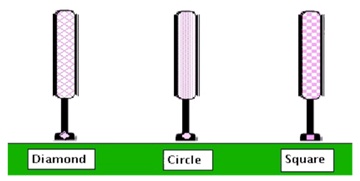
a. (1) Diamond; (2) Square; (3) Circle.
b. (1) Circle; (2) Square; (3) Diamond.
c. (1) Diamond; (2) Circle; (3) Square.
d. (1) Circle; (2) Diamond; (3) Square.
e. (1) Square; (2) Circle; (3) Diamond.
f. (1) Square; (2) Diamond; (3) Circle.
2- According to the triboelectric series shown here, what would happen if Vinyl were rubbed on Teflon?
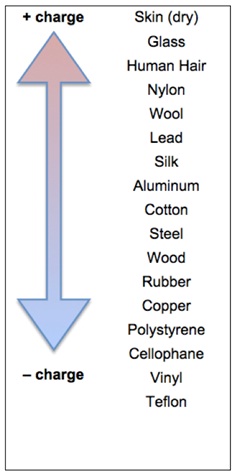
a. Both the Vinyl and the Teflon would become positively (+) charged.
b. Both the Vinyl and the Teflon would become negatively (-) charged.
c. The Teflon would become positively (+) charged and the Vinyl would become negatively (-) charged.
d. The Vinyl would become positively (+) charged and the Teflon would become negatively (-) charged.
3- Earlier in the unit you determined that when an acrylic sheet is rubbed with a Styrofoam plate (which is a trade name for a particular form of polystyrene), the acrylic becomes positively (+) charged and the Styrofoam becomes negatively (-) charged. From this information where should acrylic be placed in the triboelectric series shown here?

a. Somewhere below polystyrene
b. It is impossible to say with this information.
c. Somewhere above polystyrene
4-You have probably experienced the phenomenon of ‘static cling', particularly when taking your laundry out of the dryer. A student dries three separate loads of laundry as described in the choices below. For which load (if any) is she most likely to notice a large amount of ‘static cling'?
a. A load consisting of only cotton materials.
b. A load consisting of only nylon materials.
c. A load consisting of a mixture of cotton and nylon materials.
d. All of these loads (A, B, and C) will produce a large amount of ‘static cling'.
5- Below are images and descriptions of three different arrangements of charges from the ‘Electric Field Hockey' simulation. Which one of these would result in a goal being scored when the positively-charged puck is released?
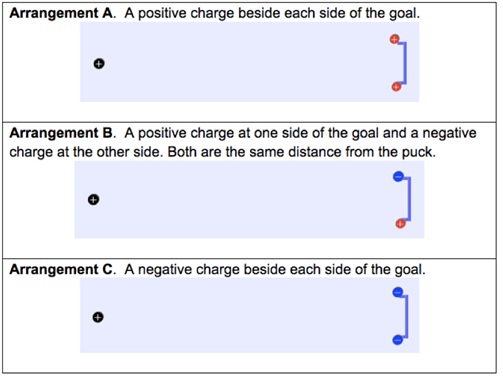
Arrangement A
Arrangement B
Arrangement C
6- The arrangement below from the ‘Electric Field Hockey' simulator shows a negatively (-) charged puck in front of the goal. Directly behind the goal is a line of three charges (-, +, -), with a second + charge directly behind the first. How would the negatively-charged puck behave when it is released, and why?

a. It would not move toward or away from the goal because there are equal numbers of + and - charges behind the goal.
b. It would be attracted toward the goal because the + charges are both in the middle of the arrangement.
c. It would repelled away from the goal because taken together, the two negative charges are nearer to it than the two positive charges.
7- When you bring a small object close to a charged tape you find that there is an attraction between them. Considering all the evidence you saw in early in this unit, what can you conclude about the charge of the small object?
a. It has the opposite charge to the tape.
b. It is uncharged.
c. Either B or C could be true.
d. It has the same charge as the tape.
8- In another class, a student drew a diagram and gave an written explanation for what happens when a negatively-charged Styrofoam plate is brought near a soda can electroscope.
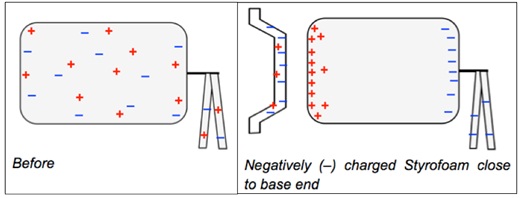
Before the plate is brought close to the base end of the soda can electroscope, the positive and negative charges are uniformly distributed in the soda can and the tinsel, and both ends of the soda can are uncharged. When the negatively (-) charged Styrofoam plate is brought next to the electroscope, all of the positive charges in the soda can (and the tinsel) move toward the negatively charged plate because of the Law of Electric Charges, which states that opposite charges attract. All of the negatively charged particles move toward the tinsel end, and into the tinsel, because like charges repel. For that reason, the negatively-charged pieces of tinsel repel each other.
Evaluate the student's model.
Can the diagram and the written explanation account for the evidence presented in the experiment and simulation movies that you watched in this extension?
a. The diagram can account for the evidence provided by the movies, but the written explanation cannot.
b. Neither the diagram nor the written explanation can account the evidence provided by the movies.
c. The written evidence can account for the evidence provided by the movies, but the diagram cannot.
d. Both the diagram and the written explanation can account for the evidence provided by the movies.
9- Which of the following pieces of evidence should lead the student to change her model (either the diagram, the written explanation, or both)? Choose all answers that apply.
a. Evidence or separate knowledge that, while both types of charges can move, they can only move a very short distance in the soda can.
b. Evidence or separate knowledge that the middle portion of the soda can (between the top and base) is uncharged when the negatively- charged plate is held near the base end.
c. Evidence that a positively-charged object attracts the tinsel, when the negatively-charged plate is held close to the electroscope's base side.
d. Evidence or separate knowledge that only one type of charge (either + or -) can actually move in the electroscope, rather than both types (+ and -) of charges moving.
e. Evidence that a negatively-charged object repels the tinsel (pushes the tinsel strands together), when the negatively-charged Styrofoam plate is being held close to the electroscope's base side.
10- Given what you have learned in this extension, which of the following would be the most appropriate assumption to make in a model that uses charged entities to explain static electric effects?
a. Both negatively (-) and positively (+) charged entities can move through materials and be transferred to other objects.
b. Positively (+) charged entities can move through materials and be transferred to other objects, but negatively (-) charged entities cannot move.
c. Negatively (-) charged entities can move through materials and be transferred to other objects, but positively (+) charged entities cannot move.
11- Suppose you had a positively (+) charged object that you wanted to make uncharged. Which would be the easiest way to do so?
a. Add some electrons to it.
b. Both A and B would be equally easy.
c. Remove some protons from it.
11- According to the reasoning you applied in the second part of this assignment, when the Styrofoam plate and acrylic sheet have been rubbed together, how does the acrylic sheet acquire a positive charge?
a. Some combination of A, B, C, and D occurs.
b. Positive (+) charges are created on the acrylic sheet.
c. The acrylic sheet transfers negative (-) charges to the Styrofoam plate.
d. Negative (-) charges are destroyed on the acrylic sheet.
e. The Styrofoam plate transfers positive (+) charges to the acrylic sheet.
12- Taking account of what they learned in this homework assignment a group of students drew these diagrams to represent their revised model for what happens when an acrylic sheet and a Styrofoam plate are rubbed together.
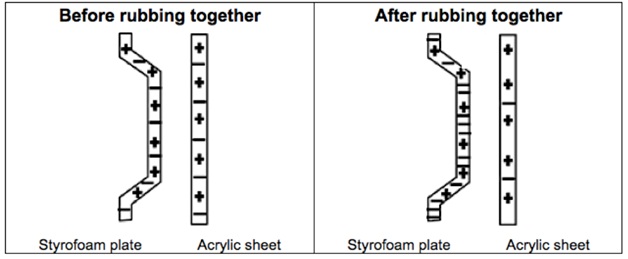
Is there a problem with this model? if so, what is it?
a. The problem is that negatively (-) charged entities have moved.
b. The problem is that it does not obey the Law of Conservation of Charge.
c. There are no problems with this model.
d. The problem is that no positively (+) charged entities have moved.
13- Which of the following is most appropriate to describe what happens when a person discharges a negatively (-) charged object by touching it?
a. Positive charges pass from the object to the person.
b. Positive charges pass from the person to the object.
c. Negative charges pass from the person to the object.
d. Negative charges pass from the object to the person.
14- Which of the following is most appropriate to describe what happens when a person discharges a positively (+) charged object by touching it?
a. Negative charges pass from the person to the object.
b. Positive charges pass from the person to the object.
c. Negative charges pass from the object to the person.
d. Positive charges pass from the object to the person.
15- You have likely experienced a static ‘shock' after walking across a carpet, just as John Travoltage did in the simulator. Which of the following best explains why this is much more likely to happen on a cold, dry, winter's day than a warm, humid, summer's day?
a. Negative charges are transferred to you from the carpet on both warm and cold days, but these excess negative charges do not remain on you. Instead, they are removed almost immediately by humid air.
b. Humid air does not undergo ‘breakdown' so the charges do not transfer to the doorknob until you touch it.
c. Negative charges are transferred to you from the carpet on a cold day, but not on a warm day.
16- Consider the following situation. Suppose a - charged object were placed above an uncharged non-metal object. Which of the diagrams shown and described below would best represent the polarization of the atoms in the non-metal object?
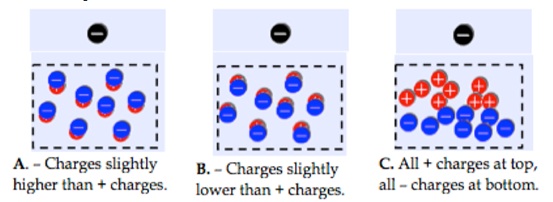
Diagram A
Diagram B
Diagram C